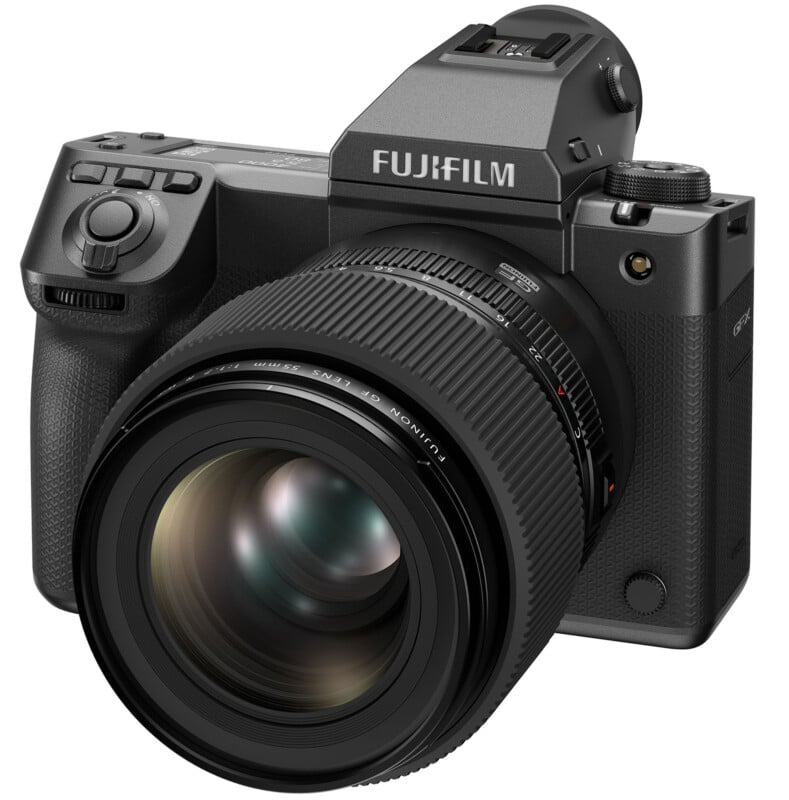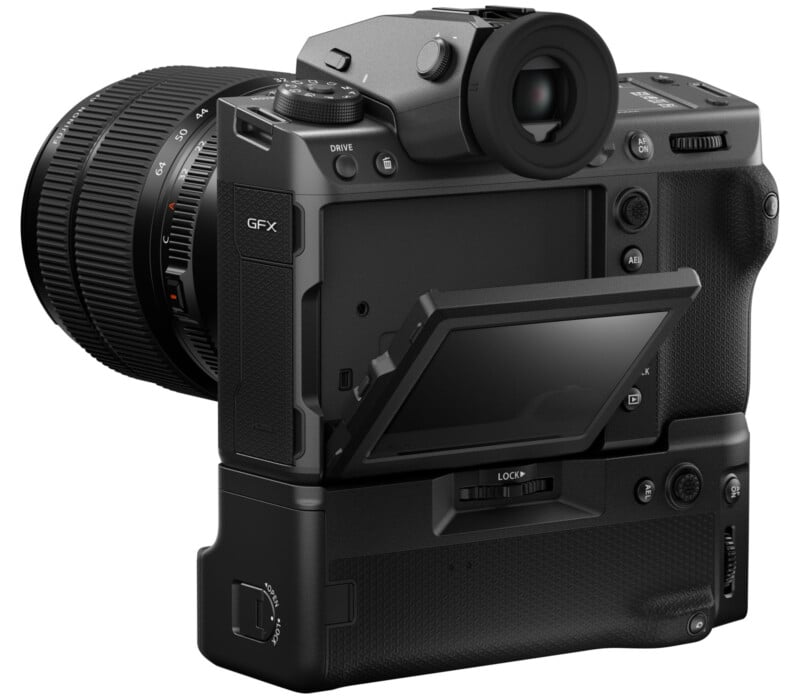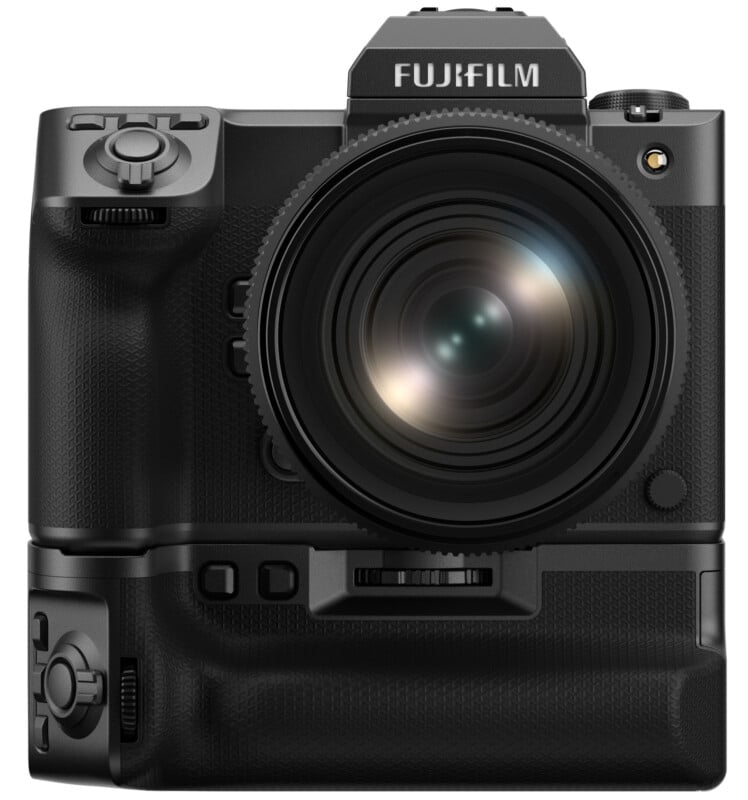![]()
At today’s X Summit in Stockholm, Sweden, Fujifilm has announced the GFX100 II. It is its new flagship medium-format mirrorless camera with better AF, faster shooting, and 8K video.
The Fujifilm GFX100 II sports a new body design and a revised 102-megapixel image sensor that offers twice the readout speed of the 102-megapixel sensor in the GFX100 and GFX100S, resulting in improvements to high-speed continuous shooting, autofocus, and video.
Newly Developed 102-megapixel High-Speed Image Sensor
At the core of the GFX100 II is a newly developed 102-megapixel CMOS II HS image sensor paired with Fujifilm’s latest fifth-generation X-Processor 5 image processing engine. The image sensor is 43.9 x 32.9 millimeters, or 54.86mm diagonally, which is 1.7 times larger than a full-frame image sensor.
The 102-megapixel image sensor’s native ISO ranges from 80 to 12,800 and can be extended to ISO 40-102,400. This is a slight change compared to the GFX100/GFX100S‘ image sensor, which ranges from ISO 100 to 12,800 (50-102,400).

Fujifilm says that the expanded ISO range results from a pixel-level innovation in the sensor design. Fujifilm also says that the new sensor’s photosites have been optimized to increase light efficiency at the edge of the sensor, improving image quality at the edges of photos.
Artificial Intelligence Makes Its Way to the GFX Family
Due to the doubled readout speed of the image sensor and faster processor, the GFX100 II offers subject detection autofocus powered by artificial intelligence (AI), a first for a GFX Series camera.
Recently featured in the Fujifilm APS-C X-H2 and X-H2S, the GFX100 II’s AI autofocus is developed using deep learning technology and updated with Fujifilm’s latest prediction AF algorithm.
The GFX100 II’s AI-based subject-detection AF can quickly detect and track various subjects, including animals (with a separate mode for birds), vehicles, and other fast-moving objects such as insects and drones.
![]()
Big Performance Gains for the Big Sensor Camera
Swifter and more powerful autofocus is not the only benefit of the GFX100 II’s faster image sensor — the medium-format mirrorless camera can also shoot faster than ever.
The GFX100 and GFX100S are already high-speed medium-format cameras, able to shoot continuously at up to five frames per second. However, the GFX100 II ups the ante with burst speeds of eight frames per second, making the fastest medium-format camera system even faster.
For reference, the Hasselblad X2D 100C, also a 100-megapixel mirrorless camera, can shoot at 3.3 frames per second despite having a very fast integrated SSD.
Although Fujifilm does not disclose precise buffer depths, the company says that buffer depths have been expanded.

8K/30p and 4K/60p Video
With the GFX100 and its sibling, the GFX100S, it was already evident that Fujifilm wants its GFX System cameras to be powerful video tools. While those two cameras incorporated 4K/30p video, the GFX100 II offers a considerable step up thanks to 8K/30p and 4K/60p video recording. The camera also records 5.8K video at up to 30p.
Further, the GFX100 II can internally record Apple ProRes 4:2:2 10-bit video, another significant first for the GFX System. The GFX100 II supports three Apple ProRes codecs, including Apple ProRes 422 HQ, Apple ProRes 422, and Apple ProRes 422 LT. Alongside ProRes, the GFX100 II can record Blackmagic RAW.
![]()
The camera can also record directly to an attached SSD via USB-C and includes a full-size HDMI (Type A) output. The camera also includes a LAN terminal.
Revised Design
The GFX100 II blends the designs of the GFX100 and the GFX100S. While the GFX100 is a graphite gray dual-gripped camera with a removable electronic viewfinder, like the original GFX50S, the GFX100S features a more compact SLR-style body and an integrated lower-resolution EVF. The GFX100S is also incompatible with a vertical battery grip, which proved a notable downside compared to the original GFX50S.
![]()
The GFX100 II, on the other hand, looks quite similar to the GFX100S at first glance but includes some of the best features of the GFX100, including a removable electronic viewfinder and compatibility with an optional battery grip.
Concerning the EVF, the GFX100 II bests both other GFX100 cameras. The GFX100 II has a 9.44-million-dot OLED EVF with 1.0x magnification. The GFX100’s 5.76-million-dot EVF (0.86x magnification), while good, looks relatively old-fashioned on paper compared to the GFX100 II’s new EVF.

Looking at the top of the GFX100 II reveals some significant changes. Following the lead of the GFX100S, the GFX100 II includes a traditional mode dial. However, much like the GFX100, the GFX100 II sports a massive top information display with space for exposure compensation, shooting mode, shutter speed, aperture, ISO, autofocus mode, subject detection, and more. The info screen comprises almost the entire right side of the camera’s top panel.
Beneath the GFX100 II’s shutter release, the camera includes three customizable function buttons, which presumably will include direct control over at least ISO and exposure compensation at default settings.
![]()
Turning to the back of the camera reveals a new texture on the GFX100 II’s grip. It also shows that the GFX100 II, like the GFX100 and GFX100S, is not returning to including a directional pad, opting instead to rely exclusively on a joystick for autofocus control and menu navigation.
Another subtle design change is visible when viewing the GFX100 II from the back — a tilted top panel. This slight tilt to the top of the camera is interesting.
8 Stops of IBIS
The GFX100 II includes a five-axis in-body image stabilization system that provides up to eight stops of image stabilization. This is a rather sizable upgrade over the GFX100S’ IBIS system that promised up to six stops of stabilization, which was a half-stop improvement compared to the GFX100.
New REALA ACE Film Simulation Brings the Total to 20
Fujifilm’s popular Film Simulations are unsurprisingly a major feature of the GFX100 II. The GFX100 II includes a new REALA ACE mode, based on Fujifilm’s color negative film, which the company claims offers a neutral color reproduction suitable for all subjects.
![]()
Workflow Improvements and Frame.io Integration
The Fujifilm GFX100 II is natively integrated with Frame.io Camera to Cloud, without any additional accessories, a world’s first as the X-H2 requires a special grip to work with Frame.io Camera to Cloud. The GFX100 II can send high-resolution RAW or JPEG photos or videos (H.264 proxies) straight to the cloud seconds after capturing them, using the camera’s built-in Wi-Fi or Ethernet LAN connection.
![]()
Pricing and Availability
“Imaging professionals rely on Fujifilm GFX System cameras and lenses to take their best images to another level,” says Victor Ha, vice president, Electronic Imaging Division and Optical Devices Division, Fujifilm North America Corporation. “GFX100 II is another incredible design and engineering feat for Fujifilm. We’re incredibly excited to see the new creative heights that will be achieved with this camera when it gets into the hands of our photographers and filmmakers.”
These photographers and filmmakers can get their hands on the GFX100 II beginning early this autumn for $7,499.99 in the United States and $10,124.99 in Canada.
The new optional battery grip, the VG-GFXII, will be available for $499.95 ($679.99 CAD).
The EVF-TL1 tilting adapter, already available, is $569 ($750 CAD). The GFX100 II is also compatible with Fujifilm’s FAN-001 to extend video recording times. The fan is $199 ($260 CAD).
Image credits: Fujifilm
